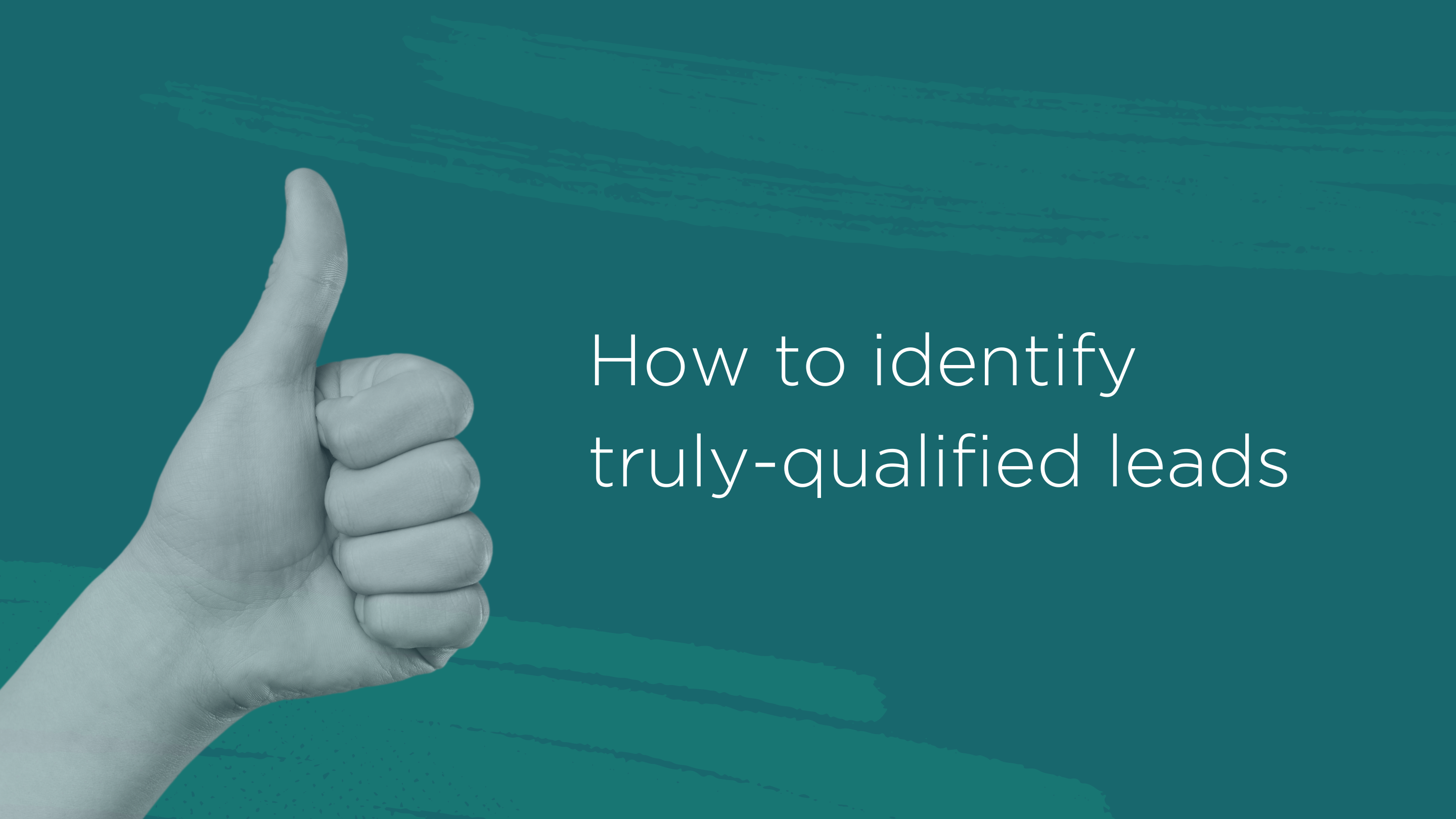Senior decision maker involvement; buying authority; customer consensus; budget; a clearly articulated need. When it comes to qualifying sales opportunities, these are the things we traditionally look for. But is that sales playbook still relevant?
In today’s world, customers are taking control of their own purchase path far more. They’re able to research and progress further along their buying journey before reaching out to reps — not only figuring out what they need faster, but also how much they’ll pay for that need. With customers researching online and taking themselves through that journey, is it enough to be looking at these things?
Here are some ways to identify truly-qualified leads in 2020.
Find out how serious are they about buying
So what if your prospect has recognised their need, have the buying authority, and have a budget? Because unfortunately, these things won’t necessarily mean they’re going to buy from you.
This is because your prospects face the added issue of not always knowing if a purchase is worth their time, money, and resources. Although they’ve done their research and are intrigued, they’re also likely intimidated by the energy required to navigate the buying process and incorporate your product into their business. It’s precisely why buyers who lack a strong desire to change ultimately decide not to take action.
To gauge just how serious your prospects are about buying, HubSpot recommends asking these questions:
- “How have you attempted to overcome this challenge in the past?”
If your prospect’s problem is relatively serious, they can probably describe at least one strategy they’ve tried before – either internally or externally. If you also follow up this question with, “What were the results?”, their answer will tell you how pressing the issue is to them. If it didn’t help or made things worse, they likely have a strong desire for change, but if the current situation is relatively stable, they probably don’t have a strong appetite for change.
- “Why is this a priority right now?”
Compelling events and deadlines usually make buyers highly eager for change. Your prospect might be reacting to an industry shift or new company initiative. Maybe they’re responsible for achieving a goal before a specific date. Or perhaps they’ve realised the true impact an obstacle is having on their business.
The above reasons suggest the buyer is motivated to act. However, if they respond to this question with an answer like, “It’s our slow season,” or “I had some extra hours, so I figured I’d look into this,” you should be more skeptical of their desire for change.
- “Change isn’t easy. How committed are you to revamping your [business area] strategy?”
Use this question to help you differentiate a buyer who’s unsure if they’re ready to take the plunge from a buyer who’s fully bought-in.
Note this question purposefully doesn’t mention your product. Your prospect might be sold on the idea of buying a solution, but that doesn’t mean they’re sold on your solution. Once you’ve established their appetite for change, you can demonstrate why your offering is the best for their needs.
- “Here’s what it takes for a customer to be successful with our product. This usually translates to X hours/week (or some other metric that shows the extent of the commitment). Is this something you’re ready to commit to?”
For many products, the real work doesn’t begin until after buyers have signed on the dotted line. Some salespeople are loath to share this fact with their prospects, believing it will scare some off.
But that’s actually to the rep’s benefit. Prospects who aren’t willing to put in the time and energy necessary to realize a product’s potential aren’t good fits. They’re highly unlikely to end up buying … and if they do, they’re going to be dissatisfied.
- “On a scale of one to 10, with one being ‘never going to buy,’ and 10 being ‘ready right now,’ what’s your timeline?”
A deal needs significant momentum to close. The buyer might seem excited about your product and its potential benefits, but if they’re dragging their feet, their appetite for change isn’t great enough. To increase it, help them calculate the costs of inaction. What are the negative consequences of maintaining the status quo?
Ideally, your prospect will give an answer in the seven to nine range. That indicates they’ll be making up her mind fairly soon. Anything lower suggests this deal isn’t one of her top priorities.
- “What’s your implementation plan?”
Committed prospects will have some idea — if not a fully fleshed-out strategy — of how they’re going to introduce a product to their team or integrate it into their workflow.
When your prospect says, “I don’t have an implementation plan,” “I haven’t gotten that far yet,” or a similar answer, don’t automatically write them off. This gives you an excellent opportunity to add value and win authority. Offer to guide them through the implementation process or help them figure out how exactly they’ll use the product.’
- “Who else will be involved in making this decision? Do they know we’re speaking?”
‘If your prospect is highly anxious to change, she’ll bring in other decision makers as soon as possible. The earlier they’re involved, the faster the buying process will be.
A prospect who’s less enthusiastic will probably put off this step. It’s a waste of time to involve their peers when they doesn’t know whether they want to pull the trigger.
If your prospect falls into the second camp, consider politely pushing back. You might say, “We’ve spent some time discussing [X challenge] and [Y objective.] It seems like accomplishing [results] would make a big impact for you. Is there a reason you haven’t brought in the other members of your team?”’
These questions should help you separate the buyers who are motivated to consider purchasing your solution from the ones who aren’t convinced they even need a solution at all.
Use change as an early-indicator
You may have noticed a trend in the above questions — change.
Unlike criteria such as budget and clear need which tell us the prospect is close to their final decision, organisational change can be a leading indicator of purchase potential.
Why? Because change boosts the likelihood a business needs to buy something as it increases the likelihood they’re looking to do things differently. As it’s the earliest indicator of an impending purchase process, it’s essentially the canary in the coalmine. And there’s a lot of change going on at the moment with the current Brexit and pandemic concerns.
So what does organisational change look like, and how do you spot it? Drivers of organisational change typically fall into internal or external categories.
Internal Drivers of Change
These company-specific circumstances often lead to a moment of “organisational reflection”, meaning their existing thinking, behaviour, processes, structure, etc. will all be looked at for areas of improvement. For example:
- Ongoing poor commercial performance
- Recent mergers, acquisitions, or divestments
- Significant changes in strategic direction
- Senior leadership turnover
- Widespread discontent with current processes, tools, data, systems or workarounds.
External Drivers of Change
External drivers of change typically impact lots of organisations at the same time, often leading the most agile businesses to act first, and many others to follow fast. The most reluctant to follow often fall dramatically behind. Because of their scope, external drivers usually represent a huge opportunity for the best sales reps to anticipate changes across businesses and their industries.
These external drivers can include:
- Changes in regulatory reform (e.g., the impact of regulatory reform on financial services companies)
- Changes in legislation (e.g., the impact of healthcare reform on the entire healthcare industry)
- Changes in technology (e.g., cloud-based computing, blockchain, mobile technology)
- Changes in micro-economic trends (e.g., the move to subscription-based services)
- Changes in macro-economic trends (e.g., shifting centres of global economic power)
Covid-19 and Brexit provide good examples of external drivers of change. We’ve already seen huge changes in the way people are working, buying, and where they choose to spend their time. And we’ve also seen a vast array of new solutions to help with these changes.
If you want to know which companies in your target industry are buying or what changes are happening for them, Shortlist can help. Book your free 1-hour lead generation review to see how you can get in front of better-qualified leads — yep, even now!



